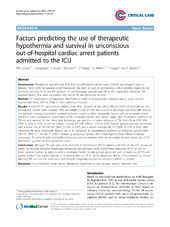| dc.description.abstract | Introduction: Therapeutic hypothermia (TH) after out-of-hospital cardiac arrest (OHCA) was adopted early in Norway. Since 2004 the general recommendation has been to cool all unconscious OHCA patients treated in the intensive care unit (ICU), but the decision to cool individual patients was left to the responsible physician. We assessed factors that were associated with use of TH and predicted survival. Method: We conducted a retrospective observational study of prospectively collected cardiac arrest and ICU registry data from 2004 to 2008 at three university hospitals. Results: A total of 715 unconscious patients older than 18 years of age, who suffered OHCA of both cardiac and non-cardiac causes, were included. With an overall TH use of 70%, the survival to discharge was 42%, with 90% of the survivors having a favourable cerebral outcome. Known positive prognostic factors such as witnessed arrest, bystander cardio pulmonary resuscitation (CPR), shockable rhythm and cardiac origin were all positive predictors of TH use and survival. On the other side, increasing age predicted a lower utilisation of TH: Odds Ratio (OR), 0.96 (95% CI, 0.94 to 0.97); as well as a lower survival: OR 0.96 (95% CI, 0.94 to 0.97). Female gender was also associated with a lower use of TH: OR 0.65 (95% CI, 0.43 to 0.97); and a poorer survival: OR 0.57 (95% CI, 0.36 to 0.92). After correcting for other prognostic factors, use of TH remained an independent predictor of improved survival with OR 1.91 (95% CI 1.18-3.06; P < 0.001). Analysing subgroups divided after initial rhythm, these effects remained unchanged for patients with shockable rhythm, but not for patients with non-shockable rhythm where use of TH and female gender lost their predictive value. Conclusions: Although TH was used in the majority of unconscious OHCA patients admitted to the ICU, actual use varied significantly between subgroups. Increasing age predicted both a decreased utilisation of TH as well as lower survival. Further, in patients with a shockable rhythm female gender predicted both a lower use of TH and poorer survival. Our results indicate an underutilisation of TH in some subgroups. Hence, more research on factors affecting TH use and the associated outcomes in subgroups of post-resuscitation patients is needed. | en_US |

